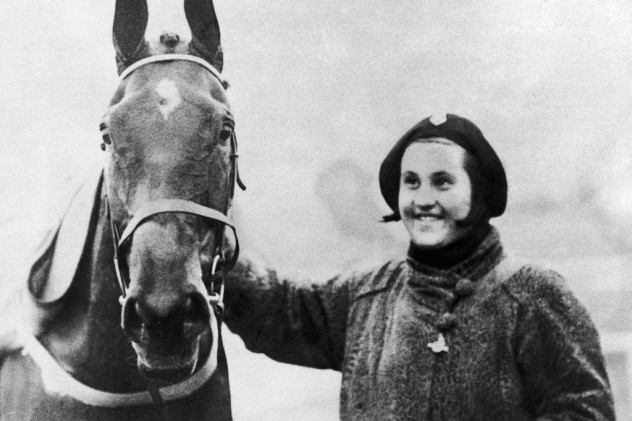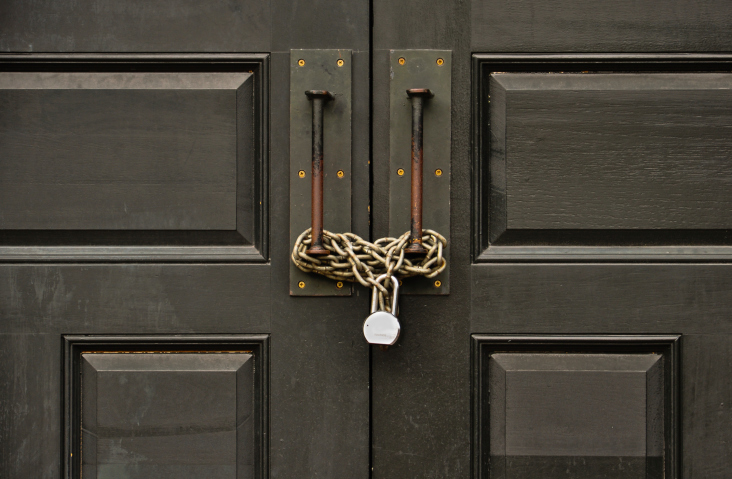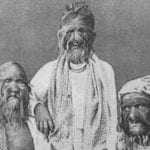 Mysteries
Mysteries  Mysteries
Mysteries  History
History 10 Surprising Stories About the Texas Rangers
 Humans
Humans 10 Philosophers Who Were Driven Mad by Their Own Theories
 Miscellaneous
Miscellaneous 10 Video-Game-Worthy Weapons and Armors from History
 Weird Stuff
Weird Stuff 10 Psychics Who Accurately Predicted Wartime Events
 The Arts
The Arts 10 Pieces of Art Inspired by a Broken Heart
 Health
Health 10 Science Fiction-Sounding New Medical Treatments
 History
History 10 Surprising Facts About the Father of Submarine Warfare
 Space
Space Ten Astonishing New Insights into Alien Worlds
 Weird Stuff
Weird Stuff 10 Bizarre Summer Solstice Rituals Still Practiced Today
 Mysteries
Mysteries Top 10 Haunting Facts About the Ghost Ship MV Alta
 History
History 10 Surprising Stories About the Texas Rangers
 Humans
Humans 10 Philosophers Who Were Driven Mad by Their Own Theories
Who's Behind Listverse?

Jamie Frater
Head Editor
Jamie founded Listverse due to an insatiable desire to share fascinating, obscure, and bizarre facts. He has been a guest speaker on numerous national radio and television stations and is a five time published author.
More About Us Miscellaneous
Miscellaneous 10 Video-Game-Worthy Weapons and Armors from History
 Weird Stuff
Weird Stuff 10 Psychics Who Accurately Predicted Wartime Events
 The Arts
The Arts 10 Pieces of Art Inspired by a Broken Heart
 Health
Health 10 Science Fiction-Sounding New Medical Treatments
 History
History 10 Surprising Facts About the Father of Submarine Warfare
 Space
Space Ten Astonishing New Insights into Alien Worlds
 Weird Stuff
Weird Stuff 10 Bizarre Summer Solstice Rituals Still Practiced Today
10 Amazing People Who Spent Years in Total Isolation
Whether they’re excluded or confined by others or simply choose their own isolation, some people have spent vast amounts of time alone. Be they reluctant prisoners, mystical hermit types, or reclusive eccentrics, their stories are sometimes tragic and always compelling.
10John Bigg

In 1649, at the end of the English Civil War, Oliver Cromwell’s puritanical Roundheads took control of England’s Parliament and hurried to put the reigning monarch, Charles I, on trial for treason. Simon Mayne, an English magistrate and Member of Parliament at the time, became one of the judges at Charles’s trial. Mayne’s clerk, a Mr. John Bigg, was rumored to be one of the hooded executioners at the king’s subsequent beheading.
Charles’s impromptu trial and execution caused widespread disapproval. The Roundheads had to eliminate half of all England’s parliamentarians before they could even bring it about. Thomas Hoyle, a retained member of “the Rump Parliament” that remained, committed suicide on the first anniversary of Charles’s death. Royalists later claimed he’d been haunted by headless phantoms. Another judge, Rowland Wilson, was said to have died of melancholy and guilt the same year.
Whether he was one of Charles’s executioners or not, John Bigg succumbed to a metaphorical death soon afterward, too. When the monarchy was restored in 1660, Bigg’s boss, Mayne, was put on trial, found guilty of regicide, and died in the Tower of London before his appeal could be heard. Perhaps out of fear or guilt, Bigg took up residence in an underground cave at Mayne’s home, Dinton Hall, and lived there alone for the rest of his days. He was last seen in an 18th century illustration, oddly resembling an Ewok.
Despite his name and oversized shoes—one of which can still be seen, though hopefully not sniffed, at the Ashmolean Museum—Bigg was not a giant man. When his clothes wore out, he simply nailed another leather strap over the old, worn-out ones, which led to his peculiar, bulky appearance.
9Dorothy Paget

The eccentric racehorse owner Dorothy Paget had been an accomplished rider in her youth, but over the years, she grew obese. Weighing in at 127 kilograms (280 lbs) and smoking 100 cigarettes a day, Paget eventually came to look twice her age. She might have slimmed down a bit by dating, since the company of men, except a few racetrack cronies, was said to make her actually vomit. Understandably, she remained single throughout her life. When she congratulated her Grand National and Cheltenham Gold Cup-winning racehorse, Golden Miller, people unkindly joked that it was the only male she’d ever kissed. Some other great wit immediately pointed out that this was only possible because the horse was a gelding.
Although she could be domineering, intimidating, and rude, Paget also suffered from debilitating shyness. She insulated herself from others at the racetrack with a herd of protective female secretaries and her signature uniform–a speckled blue tweed coat, which resembled a tent, and a beret. She sometimes locked herself in the toilets until the crowds had gone home, and when traveling by train, she would hire an entire carriage to ensure her privacy. She predominately communicated with her staff by leaving them notes and preferred to address them via a color-code system rather than calling them by name. Besides horses, it seems only one other creature received the fullness of Paget’s affections—Olga de Munn, niece of Princess Meshchersky. Meshchersky, a Russian immigrant, had run the Parisian establishment. The spoilt and unruly Paget had been forced to complete her formal education after being expelled from no less than six other schools.
By age 54, Paget was living as a recluse at her home in Chalfont Saint Giles. Now she insulated herself with stacks of yellowing copies of The Sporting Life and placed her bets over the phone. She was such a recluse that bookmakers would allow her to place bets long after races had finished, so confident were they that she could not have known the results due to her isolation. She slept through the day and worked at night, telephoning her trainers at inconsiderate hours. She was found dead early one morning, presumably by one of her color-coded staff, slumped over a race calendar. The newspapers ran acidic articles reviewing her life, which prompted Olga de Munn to defend her unfortunate friend.
8Ken Tustin

Ken Tustin is a lonely hunter—although not in the usual sense. He’s spent decades alone for months on end, freezing his knees off in the Fiordland wilderness on the west coast of New Zealand trying to photograph Canadian moose.
The first attempt to introduce moose into New Zealand took place in 1900. There were only four—10 of their companions had died during the rough ocean voyage from Canada. By the time they arrived, the four survivors were described as being as tame as pet ponies. During the course of their epic journey they also seem to have become addicted to biscuits. Only three of them ventured off when eventually released. One stayed close to the settlement of Koiterangi for years, probably in the hopes of finding a Biscuit Addicts Anonymous group. Or more biscuits.
The next batch of moose was released at Supper Cove in Dusky Sound, Fiordland, in 1910. There were 10 altogether—four males and six females. These seem to have had a more successful introduction, despite one of the females breaking her shoulder on the day of release and another being shot within a week. Free of the ravages of biscuit addiction, these moose soon adapted to their new environment. Their descendants were infrequently sighted up until 1953.
As time went on, practically everyone believed moose had died out in Fiordland due to competition for food with growing numbers of imported red deer. However, Tustin, a biologist, became convinced a small herd of moose had survived. He’s been living mostly alone in the Fiordland wilds to find proof of remaining moose ever since. His long, solitary periods in the wilderness were somewhat validated back in 2005 when DNA analysis of some animal hairs found in Fiordland confirmed that they could only have come from the descendant of a Canadian moose.
Tustin, now 74, still makes treks into the area to find evidence of the elusive moose. But, one day in 2020, he received a visitor at his house that made all his years-long efforts worth it. A young man said to Tustin, “You better make a cuppa tea, we’ve just seen a moose.” Apparently, two employees at Southern Lakes Helicopters had been out on a scenic flight near Doubtful Sound with another pilot and two paying customers. on Saturday. Newly-rated pilot Ben Young was eagerly looking for deer when he spotted an animal that many believe no longer exists in the area. As he had spent time in British Columbia, Canada, he knew what a moose looked like. With this news, Tustin made plans to return to that same area, a place more north than he had searched before.
7Blanche Monnier

She spent 25 years locked in a completely dark room, half-starved, naked, and lying on a mattress covered in lice and her own excrement. Her only companions were the rats she shared crusts of bread with. By that stage, she had aged and understandably lost her wits. Her crime? Loving someone beneath her family’s social status—or maybe sheer stubbornness, depending on how you look at it. No matter the conclusion, it seems fair to say that Blanche Monnier was the victim of a terrible injustice and that love, despite the popular aphorism, doesn’t always conquer.
Discovered by French police in the well-to-do town of Poitiers after an anonymous tip-off, Mademoiselle Monnier was rushed into care in 1901. It was first thought that she wouldn’t survive, and though she later recovered physically, her sanity was never fully restored. Meanwhile, the world was shocked to learn that the woman who later came to be known as “The Sequestered of Poitiers” had been locked in the room by members of her own family after refusing to renounce her love for an unsuccessful local lawyer.
Blanche Monnier had been an attractive, bright-eyed brunette, reportedly desired by several men in the town. But much to her upper-class family’s dismay, her heart was set on the lawyer. The Monniers, believing their reputation would be ruined if the union was allowed to go ahead, decided to prevent the marriage by confining the young woman. Her brother, a local government official, trapped her, but the plan was hatched by their mother, who was convinced the girl would soon relent. But Blanche never did.
The lawyer died 16 years before Blanche was rescued. When the shocking crime was discovered, Blanche’s mother was locked away in prison, dying of heart failure soon after realizing the true horror of her crime.
After she was released from the room, Monnier continued to suffer from mental health problems. She was diagnosed with various disorders, including anorexia nervosa, schizophrenia, exhibitionism, and coprophilia. This soon led to her admission to a psychiatric hospital in Blois, France, where she eventually died in 1913 in apparent obscurity.
In an interesting postscript, the so-called life of “The Sequestered of Poitiers” is believed by some to have haunted the French philosopher Michel Foucault, who grew up in the same town and regularly passed the Monniers’ home. A BBC documentary suggested that the philosopher’s obsession with madness and confinement may well have been inspired, at least to some extent, by the horrifying story, which he must surely have heard as a child, and which he seems to have never forgotten.
6The 5th Duke of Portland

Although the 5th Duke of Portland has been mentioned in a previous list of British eccentrics, the true extent of the mystery surrounding his seclusion remains to be told. Back in the Victorian era, it was claimed that the Duke—who stayed shut away in his room on his private estate, Welbeck Abbey—was a real-life Jekyll and Hyde. His extensive network of underground rooms and passageways may perhaps have been constructed in order to assist him in leading a double life.
The story could have come straight out of a Victorian novel. In fact, some have suggested it was the inspiration for Charles Dickens’s final, unfinished work, “The Mystery of Edwin Drood.” A widow named Anna Maria Druce insisted for decades that her father-in-law, Baker Street textile shop owner Thomas Charles Druce, had been none other than the Duke of Portland himself. Though Thomas Druce had died in 1864, a full 15 years before the Duke, Anna claimed the entire funeral had been a hoax. She asked that the coffin be exhumed and opened, certain it would either be empty or filled with lead weights. Thomas Druce, she claimed, had staged his own death to fully resume his life as the Duke.
Anna never recanted her seemingly outrageous story and went as far as to contest the inheritance of the Portland estates. She was finally committed to an asylum in 1903 due to the “stress of litigation.” Other members of the Druce family pursued the matter after her, though the evidence some of them gave was found to be false and several main witnesses were given heavy sentences for perjury. When the coffin of Thomas Druce was finally opened in 1907 and found to contain a body, the case was dismissed as “frivolous and vexatious.” However, Anna Marie Druce’s claims could well have been rooted in some long-obscured truth.
Consider the reported evidence. On the extremely rare occasions when the solitary Duke made an appearance, he was buried under three overcoats and a ridiculously oversized top hat and hid behind a huge umbrella. He mostly gave his orders through written notes. When traveling, his stagecoach always had the curtains drawn, and it was loaded onto the London-bound train, presumably with him inside. He kept apartments in London that were said to be linked to Baker Street by a secret tunnel discovered by workmen years later.
Due to his isolation, no one really knew whether the Duke was in his room at Welbeck Abbey or not. Food was delivered, but nobody ever saw him collect or eat it. Even when sick, the Duke would shout his symptoms through a slot in the door, and his doctor would shout back a diagnosis. Likewise, Thomas Druce was said to have kept his Baker Street office behind some red velvet curtains. When the curtains were drawn, employees were told to stay clear and not to bother Druce. When the Duke’s whereabouts were known, Druce’s became mysterious, and vice versa. After the funeral of Thomas Druce, the Duke was known to have resided permanently at Welbeck Abbey.
5John Slater

John Slater, a former Royal Marine commando, is a notable English eccentric with a penchant for long-distance walking and lonely coastlines. After leaving the military because: “There came a time when I lost interest in learning how to kill a man using only my thumbs,” Slater went on a mission of self-discovery, spending months living among the homeless on the streets of London. After that, he became unsettled, working dozens of jobs and wrecking a number of relationships. At one point, he volunteered to be a human exhibit in a London zoo for six months to raise money for giant pandas. His offer was turned down.
Later he went on to gain the world record for walking barefoot the entire length of Great Britain, from Land’s End to John O’Groats. He completed the walk dressed in brightly striped pajamas, while his accompanying border collie wore suede booties. To raise money for charity, he also walked the entire coastline of Scotland in just four months. Later, he built a working automobile out of “bits of old cars, washing machines, ironing boards, and Coke bottles” that people had thrown away.
Whatever Slater’s hang-up was, he finally seemed to resolve it by growing an Old Testament beard and going to live in a remote oceanfront cave on the west coast of Scotland, where he regularly stayed for up to four months at a time for at least 10 years. Twice a day, he was forced to gather his stuff and run to the back of the cave as the tide came in. At night the cave apparently became infested with rats, which would crawl over him as he slept. Unsurprisingly, his wife refused to join him, and they later divorced. As extreme as this may sound, Slater seemed to settle into it.
“There is also a cathedral-like silence which helps me think,” he once told The Herald newspaper. “I’m addicted to harmony . . . restfulness. You realize the planet’s breathing that the same energy moving these stones is moving your heart.” Slater also admitted plans to one day unleash his mystical insights and deep, cave-born wisdom on the world with the help of a large hand puppet he’d created called Muddy the Frog.
4Mary Molesworth

After her debut in the Dublin theater, Mary Molesworth’s talent and beauty were praised throughout Ireland. Unfortunately, this attracted the attention of Colonel Rochfort, a man known for his terrible temper. Mary didn’t want to marry him, but her father insisted. Rochfort had by that stage become the 1st Earl of Belvedere, and he could offer Mary land and a title. So, against her wishes, Mary Molesworth became Lady Belevedere in 1736, bearing the Earl several children. Neglected and alone on the Earl’s estate at Gaulstown, she began spending time with the Earl’s brother, Arthur, and his wife, Sarah.
At some point the Earl received a parcel of letters that implicated Mary in an adulterous affair. The poisonous suggestion was that she’d been sleeping with his brother during his frequent absences. The Earl wigged out and threatened to shoot Arthur on sight, forcing him to flee the country. Meanwhile, he confined Mary to Gaulstown. She was kept under close guard and escaped only once, returning to seek her father’s protection in Dublin. But her father refused to speak to her, handing her back to the Earl’s men as soon as they came looking for her.
Sixteen years passed with Mary locked away at Gaulstown. People had apparently mostly forgotten about her by that stage and were only reminded when Arthur returned from overseas. A trial followed, and Arthur was found guilty and ordered to pay £20,000 for wrecking the Earl’s marriage. When he couldn’t pay, he was sent to prison.
Mary remained a prisoner at Gaulstown for another 16 years, finally being set free by her son upon the Earl’s death in 1774. After her release, someone who met her wrote: “Who would believe she was the woman of the beauty of which we had heard so much? She is a wreck, weak and haggard! Her hair is white as snow, and there is a wild, scared look in her eyes, as of one who has received some terrible shock, the memory of which is ever with her. She speaks in a trembling voice which hardly rises above a whisper, and the dresses she wears are of a fashion in vogue over 30 years ago!”
Even on her death bed, Mary continued to protest her innocence—as did Arthur Rochfort, who died in his jail cell. Their tragic story became one of the greatest scandals of 18th century Ireland.
3Christopher Knight

Christopher Knight was described by high school classmates as quiet, intelligent, and nerdy. Graduating in 1984, Knight showed a brief interest in computers before walking off into the Maine woods and never looking back. In the following 27 years, he reportedly had just one human encounter—passing a hiker in the woods. Knight spoke a greeting and kept on walking.
Locals guessed there was someone hiding out somewhere nearby because their homes were frequently burgled. Knight committed hundreds of break-ins over decades. He stole sleeping bags, clothing, propane canisters, batteries for his radio, and an untold amount of food and alcohol. He was finally caught after tripping a motion sensor while raiding a camp for special needs children. When arrested, Knight claimed that his glasses were the only things he owned that were originally his—he’d stolen everything else. The police filled two pickup trucks when clearing his camp.
Knight had apparently spent his time in the woods playing his Nintendo Gameboy, meditating on an overturned bucket, watching TV, enduring the freezing winters, reading whatever books and magazines he could pilfer, getting drunk, and listening to talk radio. On his arrest, he suddenly found himself sharing a six-person cell and at the center of compensate victims of the hermit’s multiple robberies. Knight served several months in jail before confessing to an alcohol problem and being admitted into a three-year program designed to help him reintegrate into society. He was ordered to attend counseling and check in with authorities on a weekly basis. However, he was not found to be mentally ill—he simply wanted to be alone.
In 2017, a book about his life was released—Stranger in the Woods by Mike Finkel. To this day, Finkel is the only writer who has ever scored an interview with the still-reclusive figure. The book ends with Knight working in his brother’s junkyard, not far from where he made his woodland home for nearly three decades.
2William Beckford

Beckford was the only legitimate son of an enormously wealthy sugar merchant. After he inherited everything in 1770, Lord Byron is said to have referred to him as “England’s wealthiest son.” Byron and several other influential writers also acknowledged Beckford as a genius. So why did someone with so much talent and money end up a social outcast, living alone in a tower? And how did he manage to squander his fortune?
Beckford was the archetypal romantic, using his apparently limitless money to indulge his own fantasies. He never stopped collecting rare books, items of furniture, and works of art. At first, this hardly affected the steady annual income from his plantations in the West Indies. But as the slave trade was abolished, things began to change in the sugar industry, and his income declined. On top of that, Beckford poured good money after bad into his notorious architectural project, Fonthill Abbey.
Fonthill was an amazing work of neo-gothic construction. It took years to complete, but since its design was more concerned with aesthetic beauty than with the practical realities of the physical world, it collapsed within two years of Beckford selling it in 1823. Doubtless distraught at the loss of his monumental erection, Beckford moved to Bath and further indulged his Freudian obsession with raising huge towers. He became a recluse in his less famous Lansdown Tower, an unusual work of neo-classical architecture that stands 37 meters (120 ft) high and remains to this day. He also left behind one of the greatest under-appreciated treasures of gothic literature—his peculiar and highly imaginative novel Vathek. You can read it for free online.
1“Terrible Tommy” Silverstein

Tommy Silverstein is one of America’s most violent criminals, as this previous list illustrates. Jailed for armed robbery in 1977, his sentence was upgraded to life without parole after he murdered two of his fellow inmates. He was placed on “no human contact” status after killing a guard at Marion Prison in 1983. However, the verdict is still out as to whether or not his punishment fits the crime. Some human rights activists claim it breaches the American constitution, which officially outlaws “cruel and unusual punishment.”
Silverstein spent time in solitary in Atlanta before being moved and locked away alone in the bowels of Leavenworth Prison for 18 years. Finally, he was moved to the ADX Florence, a “supermax” prison in Colorado. A former warden of this institution once described it as a “clean version of Hell.” Silverstein is now “entombed” in his cell, behind a sound-proof door for 23 hours a day. He eats alone and gets just one hour of solitary recreation inside a somewhat larger cage. Some say this infernal environment is deliberately designed to drive prisoners mad and render them more compliant. The detrimental psychological effects of solitary confinement have certainly been well documented. Silverstein claims he has experienced depression, hallucinations, disorientation, and memory loss. He says he has gone “beyond the boundaries of what most human beings can psychologically tolerate.”
Silverstein spent more than 36 years in solitary confinement. He passed away in 2019 after complications from heart surgery. Though this is a record for the federal prison system, amazingly some prisoners in Louisiana were stuck in solitary confinement even longer. Herman Wallace spent 41 years in solitary and died just three days after his release at the age of 71.
HTR Williams has been writing in a cupboard under the stairs for the past three years, living off pasta sheets posted under the door twice daily. Read more for free at htrwilliams.com.








